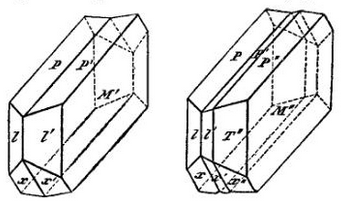1911 Encyclopædia Britannica/Albite
ALBITE, a mineral of the felspar group, belonging to the division of the plagioclases (q.v.) It is a sodium and aluminium silicate, NaAlSi3O8, and crystallizes in the anorthic system. Like all the felspars it possesses two cleavages, one perfect and the other less so, which are here inclined at an angle of 86° 24′. On the more perfect cleavage, which is parallel to the basal plane (P), is a system of fine striations, parallel to the second cleavage (M), due to twinning according to the “albite law” (figs. 1 and 2).
The hardness is 6, and the specific gravity 2.63. The colour is usually pure white, hence the name (from the Lat. albus) for the species.
Albite forms an essential constituent of many acidic igneous and crystalline rocks; in granites, diorites, andesites, &c., it occurs as a primary mineral, whilst in crystalline schists, phyllites and crystalline limestones it is of secondary (metamorphic) origin. The beautifully developed crystals so abundant in crystal-lined crevices of Alpine granites and gneisses have been deposited, with other minerals, from solution; the crystals lining veins in the slates of Tintagel in Cornwall have the same origin.
Several varieties of albite are distinguished, of which the following may be here specially mentioned. Pericline (from the Gr. περιλινἠς, “sloping”) is the name given to large opaque white crystals from the chlorite-schists of the Alps; they are tabular parallel to the direction of perfect cleavage and are twinned according to the “pericline law.” Peristerite (from the Gr. περιστερά, a dove) is characterized by a beautiful bluish sheen, somewhat resembling that seen on the neck of a pigeon; it is found mainly in Ontario. Aventurine and moonstone varieties occur, though these special appearances are more usually displayed by the oligoclase and orthoclase felspars respectively. (L. J. S.)

